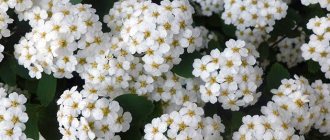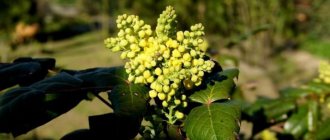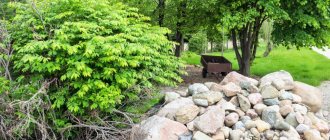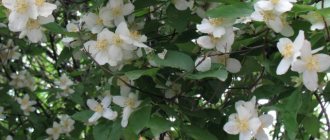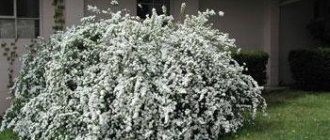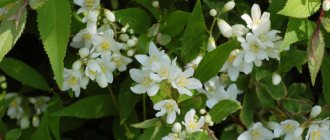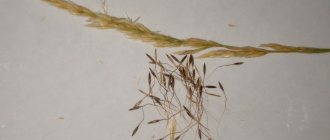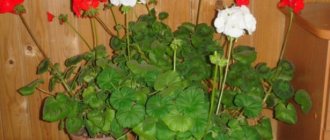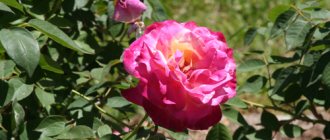The beautiful meadowsweet (also known as spirea) has been known to people for a very long time, but the high decorative value of this shrub was appreciated only with the advent of landscape design. Gardeners take care of maintaining the lushness of the bush and the luxurious flowering of spirea in the fall, by pruning and providing care in preparation for winter. But not every gardener knows that the method of cutting different types of meadowsweet is very different. We will help you understand the nuances of caring for this spectacular plant.
Varieties of spirea
The genus Spiraea is part of the Rosaceae family and includes over 80 species of ornamental deciduous shrubs. The average height of the crop is 90–170 cm, the crown circumference reaches 2.5 m. The openwork crown is made up of thin shoots that bend under the mass of inflorescences almost to the ground. Therefore, spirea is often compared to a snow-white fountain. The first flowering occurs in the 3rd-4th year of the growing season and is limited to the appearance of individual inflorescences. In subsequent years, the shrub tirelessly pleases gardeners with its splendor. The plant can act as a spectacular soloist or join a group. Due to their hardiness, unpretentiousness, and resistance to dust, spirea are often used as hedges.
If you choose the right cultivars according to flowering time, you can achieve continuity of this process for 3-3.5 months.
The timing and features of pruning shrubs directly depend on its variety. All types of spirea are usually divided according to flowering time into spring-blooming and summer-blooming. Let's look at the main representatives of these groups.
Early flowering (spring) species of meadowsweet
Snow-white flowers with a yellow core and incredibly long stamens are a characteristic characteristic of early-blooming spirea. Dense corymbose or umbrella-shaped inflorescences densely cling to thin shoots, causing them to bend to the ground. The appearance of “snow” on the branches occurs at the end of spring or beginning of summer. Flower buds are formed on last year's shoots and are located along the entire length of the branches. The May “snow storm” lasts only 2-3 weeks, fills the garden with fragrance, attracting a lot of pollinators.
The following spring types of spirea are most often found in cultivation:
- Wangutta;
- Nippon;
- Thunberg;
- oakleaf;
- Gray;
- Arguta;
- Average;
- Gorodchataya.
They differ slightly in height, shape of crown and leaves, size of flowers and inflorescences. Some representatives have a snow-white color, others have a cream color. Nippon spirea dresses up in a crimson dress in autumn, and Vangutta burns with an orange flame.
The listed varieties are light-loving, but tolerate light shading. Spiraea are capable of growing in spartan conditions, but without proper pruning and periodic rejuvenation, they first grow and look sloppy, and then begin to wither and lose their decorative effect.
Summer-blooming spirea
Representatives of this group bloom throughout the summer. They are characterized by bright, rich colors of inflorescences - pink, reddish, purple. Inflorescences are formed on the current year's growths and have the shape of panicles or large corymbs.
Summer-flowering spirea include the following species:
Like their spring sisters, summer-blooming spirea are unpretentious, light-loving, and can withstand gas pollution. The listed crops will fit perfectly into the design of any garden and will decorate a garden bed or mixborder. Gardeners are especially attracted to Japanese spirea, from which a lot of beautiful varieties and decorative variegated forms have been obtained. Cultivars of Japanese meadowsweet can be easily shaped and used to create garden sculptures.
Use in landscape design
In landscape design, spirea Vangutta is actively used in single plantings near artificial reservoirs. The weeping shape of the bush harmonizes well with the surface of the water and adds additional decorativeness to the area during the flowering period. This plant goes well with conifers as a background. You can select both decorative forms and classic spruce, pine, and thuja trees. The duo of spirea Vangutta with flower beds looks impressive. Here the role of the background plant will go to a weeping shrub.
Solitaire plantings are also relevant. If you place the Vangutta spirea in the center of the lawn or flower bed, it will become the main element that always comes to the fore. Varieties that produce repeated flowering are especially good at this quality. As part of hedges, this species holds its shape remarkably well and looks very expressive. But when planting, it is important to maintain a distance between the bases of the bushes: it should be 0.5 m.
Other abundantly flowering shrubs are well suited as companions to Spiraea Vangutta. This could be lilac or mock orange, which will provide additional decoration to the composition. It would be good if you can choose varieties with earlier and later flowering periods, allowing you to avoid the garden being exposed after the petals fall on the spirea.
For more information about Spiraea Vangutta, see the following video.
Types and timing of shrub pruning
Throughout the growing season, meadowsweet must be periodically pruned. This plant is so plastic that it can be easily shaped, and reacts very positively to pruning, throwing out more powerful shoots and forming a larger number of inflorescences. Thanks to shearing, it is possible to achieve an increase in the decorative value of the crop, because meadowsweet is a fast-growing species. It produces a lot of root shoots and shoots, so without timely trimming it will become a sloppy bush.
Depending on the goals pursued, spirea pruning is divided into the following types:
- sanitizing;
- stimulating;
- formative;
- rejuvenating.
Meadowsweet shoots are short-lived and after 1-2 years they begin to dry out. If you leave them on the bush, the branches will become a haven for pests and a breeding ground for fungal spores. Some types of shrubs do not tolerate frost very well; the tips of the branches freeze slightly. To protect the crop from diseases and restore its decorative appearance, gardeners remove diseased, dry, broken branches throughout the growing season. Frozen shoots are cut out in the spring before the buds open.
Stimulating haircut is used for early flowering meadowsweet over 3-4 years old. By removing weak shoots, branching is stimulated and flowering is enhanced. This approach will improve illumination and ventilation of the crown, which will have a beneficial effect on the health of the crop. Stimulating haircut is carried out in early autumn.
The formation of shrubs is usually done in spring or autumn. The autumn period is less busy for gardeners, so the spirea crown is most often formed in the fall.
A shaping haircut can be moderate or dramatic. In the first case, the silhouette of the bush is simply slightly adjusted, in the second, so many branches are cut off so that the crop takes the desired shape.
Plants older than 15 years will need anti-aging pruning. From this age, biological aging begins, the bush gradually loses its attractiveness. Autumn pruning is done 2-3 weeks before frost, so that the wounds have time to heal.
Pruning early flowering spireas
Early flowering spirea tend to grow a large number of shoots, and therefore require the mandatory removal of part of the shoots. If the bush grows alone, gardeners recommend creating a strong skeleton by removing weak shoots. In autumn, cut off a quarter of the shoots at soil level. Over the next season, the bush will expel new young branches.
Early flowering species are pruned after the inflorescences wither, in mid-summer, but more often the event is postponed until autumn, when the crown is clearly visible. You can’t be overzealous with cutting, because the flower buds have already been laid, so gardeners cut off only a third of the annual growth. This stimulates tillering and enhances flowering. Unbranched branches, which are often observed in spirea gray Grefsheim and Vangutta (hybrids), are cut in half, and a third of the growth is cut off at each fork.
In spring, pruning is not carried out so as not to lose some of the inflorescences. Only the frozen tips and branches broken by snow are removed.
How to properly plant spirea Vangutta in the garden
Proper planting of a shrub largely determines not only the growth rate and flowering activity, but also whether the spirea will take root in the chosen location. As mentioned earlier, Vangutta, although one of the unpretentious plants, still has its own preferences regarding soil quality and lighting. Therefore, those gardeners who have decided to grow Vangutta spirea and are wondering how to plant and care for it should know that the key to success lies in the correct choice of place for planting, selection of seedlings and adherence to planting technology.
Selection of seedlings and soil preparation
When choosing a seedling of this ornamental plant, you should pay careful attention to the condition of its root system, because it is this factor that determines the durability of the spirea and its life expectancy.
The roots must be strong, without flaws or damage. In addition, their number plays an important role - the more branches, the faster Vangutta will take root in a new place.
The branches of the bush should be smooth and free of cracks. Small buds should be visible on them.
Important! If the purchased seedling has an open root system, it should be visually examined, and then the damaged areas should be removed. In the same way, you need to shorten the excess length of the roots (no more than 20 cm). It is important that the cuts are made smoothly and accurately. After root pruning is completed, damaged top shoots should be checked and removed.
Pruning spirea blooming in summer
Summer-flowering varieties of shrubs respond well to pruning. The more shoots are removed, the more intensively the green mass grows. Haircuts are carried out every autumn, starting at the age of 3–4 years. Be sure to cut out all weak growth at the level of the root collar. In autumn or early spring, trim the branches, leaving 2-3 developed buds above the woody part.
Stimulating pruning consists of complete removal of vegetation at a height of 30 cm. The event is carried out in early spring to stimulate tillering. Spiraea, which is cared for according to all the rules, will recover very quickly and will delight you with abundant flowering already in the current season.
From the history of spirea Vangutta
In 1862, this plant was discovered in the vicinity of Paris. It was introduced into culture in 1868. 14 years later, the French botanist and gardener Elie-Abel Carriere published its description in the Gardening Journal. Under the scientifically known name Spiraea × vanhouttei, the plant was described by German botanists Pierre Louis Briot and Hermann Zabel, as evidenced by the publication in the Berlin Gardening Monthly for 1884. The hybrid was named after Louis van Goutte, the famous Belgian gardener and owner of the largest flower growing and supply company at that time. Spiraea Vangutta has been in the GBS since 1938.
Pruning after planting, replanting, dividing the bush
Planting and replanting of ornamental shrubs is carried out in the fall. At the same time, it is customary to divide bushes that are 3–4 years old to obtain new specimens. To facilitate the adaptation of the bush in a new place, planting work is combined with pruning.
The work is carried out in early autumn, as soon as there is a change in the color of the foliage. Choose a cloudy or rainy day and follow the following algorithm.
- Remove the bush from the soil, having first dug it around the perimeter of half the crown projection.
- Rinse the roots thoroughly, divide into several parts so that the division has renewal buds, shoots and a developed network of roots.
- In advance (3-4 days in advance), arrange a planting hole with a diameter and depth of 40-50 cm.
- Fill the hole with drainage made of broken bricks or crushed stone to a height of 15 cm.
- Prepare a substrate of peat, leaf soil and coarse sand (1:2:1), fill a third of the hole with it.
- Place the cutting, seedling or transplanted plant in the hole, add soil so that the root collar is level with the surface of the earth.
- Compact the substrate a little, water and mulch with peat chips.
- Remove all weak and damaged branches.
- Shorten the skeletal shoots to the level of mature wood.
- If the bush has old shoots, remove them immediately, since in the spring they will die anyway and attract pests.
Reproduction of Japanese spirea
Japanese spirea is propagated by generative and vegetative methods, however, for hybrid forms and plant varieties, the seed method is not suitable, and for other varieties, cuttings and propagation of spirea by layering are preferable, since these methods allow you to achieve reliable and quick results with minimal time and labor.
Reproduction by layering
In early spring, the lower shoot or root shoot of the spirea is bent to the ground, placed in a trench, secured in this position, leaving the top of the shoot above the surface. This method will allow you to get a single seedling with a well-developed root system by autumn. If you want to get more seedlings, then the top of the shoot should be pinched, and then young shoots will begin to grow from the side buds. In the fall, such cuttings are dug up, divided into parts according to the number of regrown shoots and planted in a permanent place.
Propagation by cuttings
Cuttings are the most productive method of propagation, since the survival rate of cuttings is 70% even without the use of growth regulators. The substrate for planting cuttings is prepared from high-moor peat (1 part) and sand (1 or 2 parts). Experienced gardeners prefer to root cuttings in September or October: they select the strongest shoots from the bush, cut them into pieces, each of which should have 4-5 leaves, and the bottom leaf is removed, leaving only the petiole, and the rest are shortened by half. Then the cuttings are soaked in water for 2-3 hours, and before planting, their lower sections are dusted with a root stimulator.
The cuttings are planted at an angle of 45º, immersing them 2 cm into the substrate, after which the cuttings are covered with a transparent cap and placed in the shade. Caring for cuttings during rooting consists of regular watering and spraying. With the onset of cold weather, the cuttings are dug in, covered with leaves on top and covered with an inverted wooden box. In spring or early summer, cuttings are planted in a school for growing, and in the fall they can be planted in a permanent place.
Growing from seeds
If you are not in a hurry and are not afraid of difficulties, then you should try to grow Japanese spirea from seeds. The seeds of this plant do not need stratification. They can be sown in spring or autumn without any preparation. The substrate for sowing needs approximately the following composition: 4 parts non-acidic peat and 1 part vermiculite. A box or container is used as a container. The seeds are sown on the surface of the substrate without covering them, after which the container is covered with film or glass and placed in the shade of the garden on the western or eastern side. As soon as the shoots appear, the covering is removed, and when the seedlings reach a height of 2 cm, they are picked based on color - by this time it will already be distinguishable. When picking, long roots are pinched by one third and planted in a larger container at a distance of 5-6 cm from each other. The seedlings are kept in the shade of deciduous trees, not forgetting to water them, in the fall they are transplanted to the school bed, and next year they can be planted in a permanent place.
Dividing the bush
You can propagate spirea by dividing the bush throughout the growing season, but if you do this in the summer, you need cloudy weather to last for at least a week after planting the divisions. The best time for the procedure is August or early September, when the soil is well warmed up and the air is already cool.
The spirea bush is dug up, capturing about 60% of the crown projection. It’s okay if you have to cut off some of the roots. Wash the roots from the ground, straighten them because they are very twisted, and divide into several parts so that each has at least 2-3 strong shoots and a decent root lobe. Shorten the long cord-like roots, treat the cuts with crushed coal and plant the cuttings in pre-prepared holes. After planting, you need to water the spirea every other day if the weather is sunny, and in cloudy weather - at least once a week.
How to rejuvenate a bush?
Mature specimens over 15 years old require anti-aging pruning. The event is carried out in the fall by completely removing the above-ground part of the bush at the level of the root collar. The same scheme is used for a plant that has been severely damaged by pests. After such a drastic intervention, summer-flowering varieties will bloom next season, and spring varieties only a year later.
Do not leave stumps after cutting. Young thin and weak branches will grow from the dormant buds on the pruning in the spring.
Reproduction of spirea
To propagate the crop, you can use two methods: cuttings from stem shoots and sowing seeds.
When propagating crops by seed, only fresh seeds are used. The fact is that spirea Vangutta seeds have very poor germination. Despite the fact that the seeds do not need to be stratified, soaked or pre-germinated before sowing, the method of seed propagation is rarely used.
Spiraea seedlings
For cuttings of spirea, semi-lignified cuttings are used, which are planted in special boxes with nutritious soil from a mixture of peat and sand in equal proportions. Germination is carried out in greenhouse conditions, providing a high level of humidity. The substrate should not dry out. Young plants are planted in separate containers every other year for subsequent growing.
Hedge modeling
A spirea hedge is an excellent solution for a garden plot. It will protect your property from dust and exhaust gases, serve as decoration and a screen from prying eyes, without causing strong shading.
After adjusting the shape of the hedge in autumn, be sure to apply potassium-phosphorus fertilizer and mulch the soil. This measure stimulates the healing of wounds and will help prepare for winter.
Systematic trimming of hedges allows you to:
- achieve density by stimulating shoot branching;
- give the plant fence compactness, a certain silhouette, height and shape;
- maintain the health of the hedge by improving ventilation and lighting of the bushes.
Hedge modeling begins a year after planting. Young bushes are pruned, removing a third of the annual growth. After 2-3 years, you can cut off up to half of each branch to maintain the shape of the green fence. As it ages, periodically trim off drying branches inside the crown.
Low pruning of an old fence will lead to the risk of drying out or freezing, since old bushes have an increased tendency to expose the root collar.
Preparing spirea for winter
Autumn care for spirea necessarily includes preparation for the dormant period. Young animals are wrapped up for the winter to avoid freezing. To do this, the branches are loosely tied together with twine and wrapped in covering material. In harsh climates, it is better to build an air-dry shelter.
The root system of spirea lies close to the soil surface, so it is better to insulate even adult bushes. Cover the root collar with a 10–15 cm thick layer of leaf or peat mulch.
With proper care, including systematic pruning and rejuvenation, the ornamental spirea shrub will decorate the garden for 20-25 years. Since spring work takes a lot of time from gardeners, it is convenient to postpone caring for lush bushes until the fall.
Pruning spirea is an important point in caring for a beautiful flowering shrub. Since there are many spireas, there are different types and varieties, it is important for the gardener to determine which bush grows on the site. According to the group, spring- or summer-flowering, pruning is carried out.
Spiraea - which one to choose?
Depending on the type and variety, bushes can have a varied structure. Dwarf varieties will serve as an excellent decoration for flower beds and rockeries; tall shrubs, reaching 2.5 m, will look most impressive alone. Spiraea is conventionally classified into 2 large groups. The first includes types of spring flowering, the second - summer.
- Spiraea Gray - received this name due to the fact that the color of its leaves on the inside is silver-gray; the most popular variety is “Grefsheim” with double inflorescences of pure white color;
- Spiraea Vangutta is a spreading bush, reaching a height of 2 meters, characterized by lush and abundant flowering;
- Spiraea Arguta - blooms in the 20th of May, the bush has a beautiful shape that practically does not require adjustment, the flowers are white with a delicate aroma.
- Japanese spirea - planting and caring for it will not be difficult, because the height of the bush does not exceed one and a half meters, and some varieties, for example, "Little Princess" are only 60 cm;
- Douglas spirea - the height of the shrub is about 1.5 m, the branches are dark in color with a red tint, the flowers are purple, collected in a panicle inflorescence.
Do I need to prune spirea after flowering?
To make the shrub decorative, regardless of the flowering period, faded panicles are removed. This is especially important for spireas, whose foliage is sometimes even more picturesque than the flowers. Decorative pruning of spirea, which blooms in late July or early August, emphasizes the expressive autumn colors of the leaves and the shape of the trimmed bush.
The technique for early spring pruning differs for shrubs that bloom in spring or summer. But after flowering, in June, it is imperative to remove branches with faded inflorescences from spireas that bloomed in May or early June. Their flower buds are laid in the fall along the entire length of the branch. Over the summer, a full-fledged shoot is formed, which will bloom buds next spring. The lush shape of bushes of the spring-flowering group is achieved by special pruning of spirea after flowering. Tall flexible shoots are shortened by a third or half. From the remaining buds, several young branches grow, on which buds form.
Those meadowsweet shrubs, as spirea is also called, that bloom in summer, can be arranged at will also after the panicles have withered. But if pruning does not take place, it is carried out in early spring. Summer-flowering species form buds with buds on the shoots of the current year. After removing old branches in April, the plant will still create new ones by the beginning of flowering in July. Pruning paniculata spirea after flowering is not as important as for those plants that bloom in the spring.
Breeding and care
Growing spirea vangutta is not particularly difficult, but still requires certain knowledge. It is propagated mainly by cuttings; seed germination is very low.
Spiraea grows quickly and can bloom the very next year after planting the seedlings. Planting and care can affect the flowering time of spirea. Autumn planting will allow you to count on flowering at the end of May. If you plant seedlings in the spring, flowers may appear by mid-summer or even autumn.
Spiraea seedlings are sometimes sold already blooming in containers. Despite all the temptation to get flowering bushes immediately after planting, you need to treat this with caution. A plant that is in the flowering stage is very vulnerable and can die from the slightest damage to the roots, which must be placed in the ground in the same condition as in the containers.
Before transplanting, the bushes need to be watered well and carefully pulled out without shaking off the soil. The hole for planting should also be moist and contain a layer of organic fertilizers, preferably humus or peat.
When to prune spirea
Varieties of such crops as:
and some other, less common ones, are pruned at the beginning of summer, when flowering has ended. All these shrubs lay flower buds in the fall. Therefore, March or April formative pruning is contraindicated for them. At this time, only rejuvenating pruning is carried out, when the entire bush is cut off at ground level.
Sanitary pruning is also acceptable, in which the frozen ends of the shoots are cut off, as well as small shoots inside the bush.
- Douglas;
- Boumalda;
- Billard;
- Willow;
- Birch leaf;
- Japanese;
- White;
- Felt
and several more less common species are pruned either after flowering, from late July-early August, or in early spring. Plants form buds for buds on shoots growing in spring. When working with spirea, you need to know that shaping the bush helps create a larger number of shoots with flower buds.
Types of pruning
When pruning a summer-flowering spirea, several different pruning methods can be applied to it, depending on the age and purpose of planting the shrub. On single bushes, pruning is carried out starting from 3-4 years of age, so that more new shoots are formed for flowering. For proper pruning of spirea, the following types of treatment are practiced in the spring:
- sanitary or cosmetic;
- formative;
- stimulating;
- rejuvenating.
Separately, you can trim spirea, which creates hedges.
Almost the same types of pruning are used for spring-flowering meadowsweet, but they are carried out after flowering. Spirea cuttings are easily tolerated by the plant in summer. Radical treatments to rejuvenate bushes are also carried out in the spring.
A beautiful shrub is formed by pruning and rejuvenation.
How to prune spirea correctly
They work with the bushes as soon as the snow melts. By carrying out sanitary pruning of any meadowsweet bushes, they get rid of damaged shoots and weak growth inside the bush. The plant gives strength to healthy branches, increasing the number of buds. Remove all last year's dry inflorescences from summer flowering bushes. And for early-flowering spirea, care includes pruning weak branches and old, 7-10-year-old shoots in March-April. The frozen tops are also cut off. When shortening the shoot, make sure that the cut is above the bud that grows outward.
Stimulating treatment means shortening the branches so that shoots come from them. The shrub becomes more luxuriant and looks more decorative with many inflorescences.
Young shoots of meadowsweet, which blooms in the summer, are shortened above well-developed buds, from which branches with buds grow in the spring. The same procedure for spring flowering species is performed in June. Bushes with old shoots are transformed, leaving only 25-30 cm of the trunk above the ground. The plant will resume more luxuriantly.
Formative pruning of spirea bushes is also carried out in spring or summer. When cutting off parts of the shoots for the growth of new branches, they try to make the cutting lines at the same level, gradually rounding the silhouette of the bush. The formation of a hedge from meadowsweet bushes, which blooms in July, is postponed until the end of August; in the spring all that remains is to trim the lines. At the same time, the bush is thinned out inside, removing old and twisted branches. Thickening can provoke the development of fungal diseases or create a cozy environment for pests. Control the thickening of the meadowsweet bush once every 2-3 years. To form and trim early-flowering spirea, frozen branches are removed and dense thickets are thinned out. To improve tillering, the longest shoots are shortened by 20-25 cm.
Shrub propagation methods
Let's consider how spirea reproduces and which method is most appropriate depending on the circumstances.
Reproduction by division
This method is well suited for older plants.
To do this, dig up a bush and divide it into several parts with pruners. Each part should have 2-3 shoots. Slightly shorten the roots, place the plant in the hole, spread the roots to the sides and cover with soil. After planting the plant, further care of Japanese spirea is not labor-intensive. Moderate watering is necessary until rooting.
This method is used from the second half of June to September-October. Annual shoots are cut, cut into cuttings (5-6 leaves each) and planted in a mixture of river sand and peat (1:1). The bottom leaf of the cutting is removed, and the rest is cut in half.
Important! The ends of the cuttings must be treated with a stimulator for root formation (“Kornevin”, “Root”, etc.)
The cuttings are covered with glass or film. For a positive result, it is necessary to water once every 4 days and spray the shoots.
Propagation of spirea by cuttings in the fall is different in that the autumn cuttings are wrapped in fallen leaves, covered with a box and waited until spring. For the winter, summer cuttings are also insulated with foliage, and in the spring they are planted in the ground.
Reproduction by layering
Reproduction by layering is a less labor-intensive method. To do this, in early spring, before the leaves bloom, it is necessary to tilt the lower branches of the plant and sprinkle them with soil in a horizontal position.
Did you know?
The inclined position of the cutting stimulates root growth, and the vertical position stimulates the growth of the top.
The attached branches need to be watered throughout the season, and by autumn roots will appear on them. As a result, we get an independent plant bush that can be transplanted to the right place in the spring.
Since Japanese spirea is a hybrid, its seeds do not retain varietal qualities, so propagation by seeds is not advisable. This method can be used for non-hybrid varieties. Sow the seeds in spring in a special box. Shoots should appear in 10 days. Planting in open ground is carried out after 3 months. This method is used if it is necessary to obtain a large number of spireas of one variety.
Methods for autumn pruning of early-flowering and late-flowering varieties of spirea
Spiraea bushes are widely used in decoration
garden plots. This plant is unpretentious, highly decorative, and responds to pruning by increasing flowering and growth. By correctly selecting spirea varieties, continuous flowering can be achieved, lasting up to 100 days.
The shrub is planted in single plantings and as a hedge. Spirea pruning is carried out throughout the growing season. In solo plantings, pruning is used to enhance the decorative effect. To do this, the bush is thinned out, achieving abundant flowering and foliage. created by removing a small part of the internal shoots, cutting the bush to height, giving it the desired shape.
Early-blooming spirea bloom with white flowers formed on last year's shoots. Flower buds are distributed along the entire length of the shoot. Early flowering varieties include:
- Spiraea Vagutta;
- sharp-serrated;
- oak-leaved;
- average;
- Nipponian.
Flowering occurs in May - June. Pruning in single plantings involves removing weakened, intertwining shoots and forming the skeleton of the bush from strong, healthy branches. Spiraea bushes are distinguished by good tillering and rapid growth. To prevent the bush from losing its decorative appearance, 1/4-1/5 of all shoots are removed annually in the fall, cutting them out at soil level. This stimulates the growth of new shoots next year.
Faded shoots are removed immediately after flowering or at the beginning of autumn, leaving young, strong shoots. Every 2-3 years, the bush is thinned out, bent branches, thinned, weakened branches inside the bush are carefully removed. Once every 7-10 years, the spirea is well cut out, eliminating all old branches, leaving only 5-7 young branches.
Features of pruning spirea of different varieties
To tidy up the meadowsweet bush that grows in the garden, you only need to study its characteristic data and determine the type.
Pruning white spirea after flowering
The species is widespread in cities and towns of Russia. Branches with brown bark form a bush up to 1.5-1.7 m high. The leaves have sharp tips. Snow-white inflorescences, fluffy due to numerous long stamens, bloom in July. Wilted shields are cut off in August so that the plant does not waste energy on producing seeds, and the branches become stronger. In spring, meadowsweet is cleared of frozen and broken branches and a silhouette is formed. Starting from the age of 4, the bush is periodically cut down to 30 cm above the ground every few years.
Pruning spirea Bride
The favorite spring-flowering plant in many gardens in April is only cleared of frozen tops and thinned out. Spiraea Vangutta, this is the species name of the people's favorite, can grow up to 3 m, with the same crown diameter. Flowers bloom on drooping branches in a picturesque white waterfall. For this spirea, summer pruning begins after flowering. Each long shoot is shortened by half. Branched branches - one third. In spring, the bush is rejuvenated by getting rid of trunks older than 7 years.
Pruning Spiraea Thunberg
This species is similar to Spiraea Wangutta, but its flowers are not as fluffy because the stamens are smaller and shorter. The shoots appear longer and more graceful. And it blooms earlier, when there are no leaves on the branches yet. Apply formative pruning of spring spirea after flowering, from June.
Pruning Spiraea Macrophila
For a powerful, up to 1.3-1.5 m, and fast-growing species with large, bright leaves, early spring pruning is applicable. The variety is magnificent; not only are the pink flowers that bloom in July decorative, but also the leaves are 15-20 cm long and 8-10 cm wide.
In spring the foliage takes on a somewhat reddish hue, and in autumn it turns golden-purple. There is one subtlety when pruning a plant. When an adult bush is cut off at the ground, leaving only 7-12 cm of trunks, the upper foliage of the growing shoots will be colored burgundy-red. After 3-4 years, all shoots are periodically shortened in April or May to 30 cm above the soil.
How to prune willow spirea
A short, up to 1-1.2 m, bush of this type of meadowsweet with narrow leaves captivates with white and pink paniculate inflorescences, up to 20 cm in length, which bloom in summer. Pruning of willow spirea is standard, as for all summer-flowering species, in April.
General rules for planting spirea
Spiraea should be planted in slightly acidic, or better yet, pH-neutral soils. The soil should be rich in nutrients, with normal aeration. Spring-flowering spireas are best planted in the fall, while summer-flowering ones take root well in both spring and autumn. Many gardeners are of the opinion that the best month for planting summer-flowering varieties is September. Conifers - spruce, juniper, thuja - can be excellent neighbors for spirea.
Before planting, spirea cuttings are soaked in a fungicide solution for several hours.
Each variety of spirea has individual characteristics, but there are planting rules common to all types. If you adhere to them, the plant will take root well and develop normally in the future. Recommendations from experienced gardeners:
- Planting material must be treated with a fungicide.
- Damaged parts of the cuttings should be removed.
- It is best to plant in leaf or turf soil. If the soil is poor, it is fertilized by adding peat or a mixture of leaf soil and sand.
- You should create a drainage layer 15-20 cm thick. Broken brick, leaf soil, peat and sand are suitable for this.
- The cuttings should be planted to a depth of about 0.5 m.
- The root collar should be flush with the ground or buried 1-2 cm.
- Ideal weather for planting is cloudy and rainy.
- After planting the plant in the ground, water it and sprinkle it with peat or sawdust.
The hole for spirea should be one third larger than the root system of the plant. It is dug in 2-4 days and allowed to stand. Then they arrange drainage, lower the plant into the hole, cover it with earth and compact it. If spirea is propagated by dividing the bush, then the plant is removed from the ground, placed in water to separate the soil, and then cut into pieces with pruners, each of which should have a good root lobe and a pair of shoots.
It is better to first plant the cuttings in a pot or tray indoors, and only then in open ground
Care after pruning
After removing branches or parts of shoots, meadowsweet is watered abundantly and fed while mulching, using peat or compost. After summer pruning, the bush is maintained with a mixture of organic matter and minerals. Mullein is prepared in a ratio of 1:5. Add 10 g of superphosphate, already diluted in a liter of hot water and left for 24 hours, to the bucket of mullein infusion. 10 liters of liquid fertilizer is poured under 1 bush. The day before fertilizing, water the bush so that the nutrients penetrate into the damp soil and are quickly absorbed by the roots. Some time after applying fertilizing, the tree trunk circle is shed with another bucket of water if the soil is not sufficiently moistened. Sawdust or composted leaves are suitable as mulch.
Description and varieties
French breeders bred this species in the second half of the 19th century by crossing Cantonese and three-lobed spirea. Gardeners immediately fell in love with it, and have not lost popularity since then. Spiraea Vangutta is a spherical shrub with numerous spreading branches. The leaves are round, obovate, with finely toothed edges, dark green in color, and bluish-green on the underside. In autumn they turn red-orange in color.
At the moment of abundant flowering, the shoots cascade towards the ground. It blooms in spring, from mid-May, in June - depending on the region of growth. But it may re-bloom slightly in August. At the moment of abundant flowering, the shoots cascade towards the ground. Spiraea flowers are small, bright white, clustered in numerous, dense hemispherical inflorescences.
It is characterized by shade tolerance, unpretentiousness and high growth energy. The species is frost-resistant, but if the temperature drops significantly, the tips of young branches may freeze. Widely used by landscape designers and simple gardeners to decorate summer cottages and create hedges. Suitable for planting in mixed groups and as a single plant. It prefers fertile, loose, well-drained soil with neutral acidity, but can grow successfully in different types of soil.
Gold Fontaine
Spiraea Gold Fountain appeared as a result of a mutation of Spiraea Wangutta. It has more pronounced decorative qualities. This is a compact, graceful deciduous shrub with a spherical shape. The shoots are orange-reddish, spreading, arched, up to 1.2 meters high. Spiraea grows up to 1.5 meters in width. Gold Fontaine is growing quite slowly. During the season, the growth is only 15-20 centimeters.
Young foliage turns orange-red in spring; in summer, its color changes to a spectacular deep yellow. The leaves are oval, slightly lobed, with a glossy sheen. A prerequisite for preserving decorative, golden foliage is planting in open sun. When grown in the shade it turns green.
The flowers of Gold Fontaine spirea are numerous, small, white, grouped in hemispherical inflorescences. They have a persistent fragrant, honey aroma. This is truly a golden fountain in the garden. Excellent for forming hedges, in solo and group compositions, together with conifers and other deciduous plants. Spiraea Gold Fontain is used by landscape designers for urban landscaping. It is characterized by high frost resistance. This variety can be grown in any type of soil.
Pink Ice
Spiraea Pink Ice is a compact shrub with original, variegated foliage and strongly drooping red branches. The plant is spherical in shape, the height and width of the bush are similar - from 1.5 to 2.0 meters. Young leaves are creamy white, less often pinkish. As they grow, they acquire a pale green color, with abundant cream spots appearing.
Pink Ice spirea blooms in May-June. Numerous small white flowers bloom on it. They are collected in dense, beautiful, hemispherical inflorescences that tightly cover the shoots. Looks impressive in contrasting compositions, for example, with barberry. Grows well in soils without stagnant water, with acidity ranging from slightly acidic to alkaline. Good frost resistance, but at very low temperatures the tips of young shoots may freeze.
Landscape design: spirea is indispensable for creating park compositions
Photos of park compositions of the world's best gardens prove that spirea Wangutta is used for planting in parks by landscape architects from different countries. The high decorative qualities of the shrub, its spherical shape, amazing white flowers, allow the plant to be used to create complex compositions and in solitaire plantings.
Spreading spirea bushes are suitable for planting on a green lawn, along paths, near pools and fountains. The plant can easily decorate low fences, dilapidated walls of buildings and outbuildings.
Spiraea Vangutta is ideal for architectural compositions that include small decorative forms of park equipment (benches, swings, playgrounds).
Growing spirea Vangutta: video
Spiraea: photo
Growing a bush
Despite all its endurance and unpretentiousness, spirea prefers planting in well-lit areas. And, of course, it shows the best results when grown on loose, well-drained soils.
What should the soil be like?
Prefers fertile, loose, drained soil with neutral acidity. But spirea can develop successfully in different types of soil. With high soil density, digging a larger planting hole is required. It is advisable to pour a drainage layer of crushed stone, expanded clay, and small pieces of brick at the bottom.
Choosing a location on the site and preparing a planting hole
Meadowsweet is a rather unpretentious plant, however, for good growth and long flowering, a number of conditions must be met. The root system of the shrub develops horizontally and forms a lot of shoots, so there should be enough free space around. Spiraea should not be placed in a shady part of the garden; plantings look most advantageous in open, well-lit areas.
The planting hole is prepared several days before the seedling takes root. Any soil is suitable for growing spirea; it is important that it is nutritious and not too heavy. The size of the planting hole depends on the volume of the root system of the shrub being planted and should be 1.5–2 times larger. It’s even better to dig up an area measuring 100x100 cm and apply the required amount of fertilizer, so you don’t have to worry that as the seedling grows, it will suffer from a lack of nutrients. Too dense and depleted soils are diluted using the following components:
- leaf soil - 2 parts,
- fibrous peat substrate - 1 part,
- coarse sand – 1 part.
All components are mixed and before filling the hole, a drainage layer of 10–15 cm is placed on the bottom. You can use broken brick mixed with pieces of foam plastic or small stones.
Planting process and scheme
When planting spirea seedlings with an open root system (ORS), especially large-sized specimens, it is important to observe the planting deadlines. Autumn is the optimal time for this. It can be planted from the beginning to the end of September, in some cases until mid-October, depending on the region of the country. The main conditions for successful transplantation are absence of heat, cloudy weather and high soil moisture.
If there is little rain in the fall, it is necessary to provide frequent watering after planting. They are also planted in early spring, before the start of sap flow in the shoots. But seedlings with a closed root system (ZRS) are planted throughout the season. If the soil at the planting site is suitable - loose, well-drained, then the size of the planting hole will be 25-30% larger than the root of the transplanted plant. And the depth of the hole is 40-50 centimeters.
But if the soil is clayey, heavy, and if water stagnation is possible, then the size of the planting hole will be 2-3 times larger than the root spirea. After digging, the planting holes are filled with specially prepared substrate. Here is a description of the universal soil mixture:
- 1 part of clean river sand, preferably coarse-grained;
- 1 part neutral peat;
- 2 parts of turf or leaf soil;
- 1 part well-rotted manure.
The distance between Vangutta spirea bushes depends on the beginning of flowering and the purpose of planting. Spireas that bloom in summer are planted in group plantings at a distance of 0.5-0.7 meters from each other. When creating a hedge, plants are planted at a distance of 40-50 centimeters. When placed in 2 rows, the row spacing is 30-40 centimeters.
Spring-flowering varieties are placed more freely. To create a hedge, the distance between spirea is 0.7-1.0 meters. And when creating group plantings - 1.0-1.5 meters. A day before planting, the root spirea is soaked in a solution of growth stimulator and fungicide. When planting, a substrate is poured onto the bottom of the hole, a seedling is placed on it, and the roots are carefully straightened. Then the hole is filled with the remaining substrate, the soil is lightly compacted and water is spilled abundantly.
Spiraea Wangutta - from planting to care
After purchasing a seedling, it is necessary to prepare a place and a planting hole for growth and formation of the root system. All this is necessary for the health of the plant and its lush flowering.
Selection of seedlings
Development, health and flowering depend on the selected seedling. Therefore, spirea must be purchased from nurseries or from trusted suppliers. When purchasing, you should pay attention to the root system. It is desirable that it be well developed, without signs of damage or drying out.
The bark should be smooth, without mechanical defects and signs of disease and rot. It is better to purchase seedlings in spring or autumn. It is preferable to purchase them in containers, since plants with an open root system tolerate replanting very painfully.
Site preparation and soil requirements
Vangutta is an unpretentious plant and can grow on any soil. But for abundant and long flowering, it is better to plant the shrub on sandy or sandy loam soil with moderate humidity. Acidity should be 5-6 Ph.
When planting a shrub, choose a place with diffused light, since in the shade it will not produce abundant flowering.
Planting rules - expert advice
It is preferable to plant spirea in the fall, after the leaves have dropped. But many gardeners plant in early spring, before the sap begins to flow. With autumn, the bush will bloom in the spring months, with spring - at the end of summer.
Flowers appear on shoots that are more than 2 years old.
In order for the plant to feel comfortable in a new place, the planting hole is dug 20 cm larger than the size of the root system. A drainage layer of 15 cm is laid at the bottom. Broken brick, expanded clay or river sand are suitable for this. The distance between bushes should not be less than 1 meter.
After 2-3 days of digging the hole, planting begins. The seedling's long, damaged, rotten roots are cut off and placed in the center of the planting hole. It is filled with a mixture consisting of turf soil, peat and river sand in a ratio of 2:1:1. Compact, mulch and shed plenty of warm water.
Crop care - watering, fertilizing, pruning
Caring for shrubs consists of timely watering, loosening the soil, applying fertilizers, pruning and preparing for winter.
Abundant moisture is necessary only in dry weather and after pruning, since overwatering affects the size and number of inflorescences.
Feeding is carried out twice a season:
- in early spring before flowering - complex mineral fertilizers;
- in the fall, in preparation for winter - potassium-phosphorus.
Regular pruning is an important part of plant care. It is carried out for better flowering and creating a decorative crown. The procedure is carried out only 2 years after planting the seedling.
Decorative pruning is best done in the fall, when flowering ends. To do this, the shoots are shortened by ¼ of the length. Sanitary - in early spring, removing all dry shoots that have not overwintered. After 7-8 years, anti-aging pruning is done. Old branches are cut to form a stump.
Shrub pruning is presented in the video:
Preparing for winter
Vangutta is a frost-resistant shrub that can tolerate frosts without shelter down to -45 degrees. Only seedlings need it. Young shoots are tied and covered with spruce branches or breathable covering material.
Care instructions
Spiraea is not an overly whimsical plant, but for active growth, spectacular and abundant flowering, it is necessary to provide the necessary care. It consists of watering, fertilizing and timely pruning, as well as preventive protection from diseases and pests.
Watering and soil care
Regular weeding, as well as superficial loosening of the soil, will facilitate access of oxygen to the roots, and will also improve the wetness of the soil during watering and the absorption of fertilizers when fertilizing. When mulching the root zone of spirea, there is no need for loosening and weeding. But it is important to monitor the thickness of the mulch; its layer should be at least 10 centimeters.
The plant does not tolerate stagnant water in the root area, so the gardener determines the frequency of watering himself, depending on the composition of the soil. But, basically, the bushes are watered generously 3-4 times a month, and even more often during periods of extreme heat. Care also involves generously spraying the crown, which has a beneficial effect on the growth of spirea.
Feeding and fertilizing the plant
With a planting hole of the required size, filled with a truly nutritious substrate, the spirea does not need to be fertilized at all for the first year. In subsequent years, one treatment per season will be sufficient - with complex phosphorus-potassium fertilizer. And, of course, mulching the tree trunk with organic matter, in particular, rotted manure.
Pruning Spiraea
For abundant, beautiful flowering, plants form a crown and also carry out sanitary cleaning. All diseased, dried out, old twigs, leaves and inflorescences are periodically removed. But for successful wintering, all pruning procedures are carried out before the onset of cold weather.
The number of prunings for decorative crown formation is 2-4 per season, depending on the growth energy. Spiraea tolerates pruning well. When pruning, the gardener must remember that spirea blooms on the shoots of the second year. And it is important not to overdo it; if necessary, you need to leave 1-2 strong buds on the shoot.
Diseases and pests
First of all, it is necessary to maintain the overall health of the plants. But if agricultural practices are not followed, spirea becomes more susceptible to diseases and pests. Damage by aphids, sawflies, and gall midges is possible. For prevention and direct control of them, spraying with a solution of insecticides is used - Aktara, Aktellik, Enzhio.
High humidity and acidification of the soil can provoke an outbreak of fungal diseases. To combat them, systemic fungicides are used - Infinito, Falcon or contact copper-containing preparations, such as Medyan Extra.
Reproduction of Spiraea
The shrub is propagated by cuttings, sowing seeds and rooting. Spiraea seeds germinate poorly; it is advisable to use only fresh seed. In the conditions of a summer house and garden plot, for propagation, it is preferable to dig up and root root shoots in pots.
Therefore, for mass production of seedlings, propagation by semi-lignified cuttings is used. To root cuttings, the following conditions must be met:
- the length of the cuttings is on average 15-20 centimeters;
- removing leaves 3/4 of the length of the cutting;
- soaking for a day in a solution of a growth stimulator or dusting the cut before planting;
- using a rooting substrate consisting of non-acidic peat and agroperlite;
- rooting cuttings in a mini greenhouse or greenhouse;
- regular spraying of cuttings or creating “fog”.
Diseases and pests
Spiraea Vangutta is quite resistant to various types of diseases and pests. Excessive soil moisture can weaken the immune system and increase the risk of infection. For prevention purposes, it is recommended to monitor the abundance of watering and drain the soil if necessary. It will be useful after the snow melts, but before buds form, to sanitize the bushes with Fitoverm solution in a dosage of 1 ampoule per 10 liters of water. This volume is enough for 5 plants.
This spraying prevents the appearance of gall midges, garden snails, common and beet aphids. To identify dangerous insects, you need to regularly inspect the bushes - this is how you can detect spider mites or sawflies. The affected shoots are pruned, and the separation areas are treated with garden varnish. Diseased branches must be burned, the remaining part of the bush is sprayed with fungicidal compounds: 0.3% karbofos and its analogues.
To avoid the appearance of fungal spores on the plant and prevent infection with powdery mildew, it is recommended to carry out preventive treatment even before flowering.
For this, Bordeaux mixture is used, consisting of a 1% solution of copper sulfate and lime.
